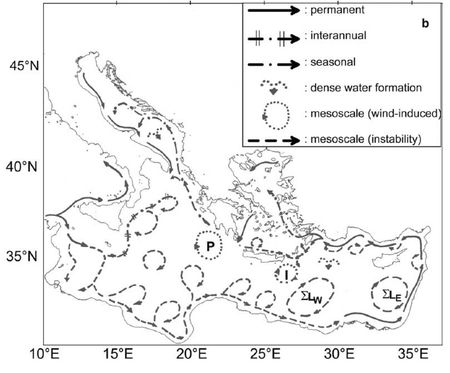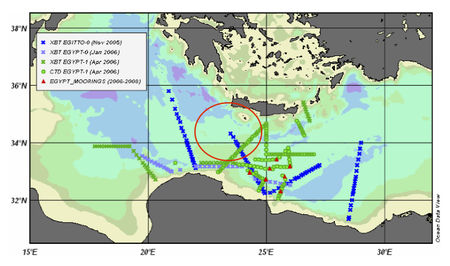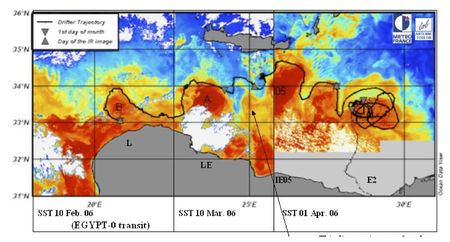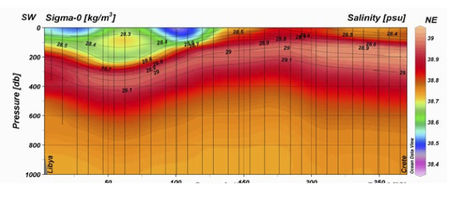The main objective of EGYPT is to investigate the circulation of the water masses in the eastern basin of the Mediterranean, which, strangely enough, is still debated ~100 years after the first circulation schema was drawn by Nielsen (in 1912).
Eddies and GYres Paths Tracking
coordinated by I.Taupier-Letage *(a)
* Corresponding author : Isabelle Taupier-Letage
(a) : Mediterranean Institute of Oceanography, CNRS UMR 7294, AMU UM 110, IRD UMR 235, ISTV - CS 20330, F-83507 La Seyne, France
The EGYPT (Eddies and GYres Paths Tracking) program was conducted from 2005 to 2007 to collect in situ observations in order to investigate the surface circulation in the eastern basin of the Mediterranean Sea off Libya and Egypt. Indeed, the path of Atlantic Water in the south was still debated. The main objective was to investigate the general circulation of the water masses with a focus on the surface circulation and the mesoscale phenomena that disturb it. The strategy was to combine both observations and model simulations, to be complemented by process studies for improved understanding. The EGYPT consortium included teams from its italian counterpart EGITTO (OGS-Trieste), and teams from LOCEAN/UPMC, from Tunisia (INSTM-Tunis) and EGYPT (NIOF and University of Alexandria). The EGYPT french part received funding from CNRS/INSU (programs LEFE/IDAO and GMMC), the Région Provence Alpes Côte d’Azur, EGIDE and benefitted from the french oceanographic fleet shiptime.
Scientific Interest
The Mediterranean Sea is composed with two semi-enclosed basins where specific climatic conditions impose an excess of evaporation over precipitation and river runoff. The consequence is a decrease of the sea level compensated by an inflow of Atlantic Water (AW) at the surface in Gibraltar. AW is progressively transformed in denser waters during its circulation in the different subbasins of the Mediterranean Sea, with specific zones identified for mixing and sinking.
In time, the circulation of AW in the eastern basin of the Mediterranean Sea has been described differently, according to two major representations. The first surface circulation scheme, drawn by Nielsen in 1912, favoured a counterclockwise circulation in the whole basin, with AW flowing in its southern part as a broad flow off Libya and Egypt (from the Ionian to the Levantine subbasins), then continuing along Middle-East and Turkey before flowing back westwards. Three studies conducted by Ovchinnikov (1966), Lacombe and Tchernia (1972) and Robinson (1991) completed this scheme. A more recent study, conducted by the POEM group in 1992, proposed a different scheme of the surface circulation : a clockwise circulation in the northern part of the Ionian continuing offshore across the basin from the Cretan to the central part of the Levantine as the so-called “Mid-Mediterranean Jet” (MMJ). This jet is depicted then as splitting both clockwise in the southeastern part of the basin and counterclockwise off Turkey (where this representation agrees with the former). This became the most widely-accepted scheme.
Figure 1 : New surface circulation scheme proposed by Hamad et al., 2005
But recent studies (Millot and Taupier-Letage, 2005a; Hamad et al., 2005 - fig.1) based on a thorough analysis of thermal satellite images and on the few available CTD profiles led to propose a schema with a Libyo-Egyptian Current (LEC) flowing alongslope. It is basically a refined version of the historical ones : the circulation of AW is counterclockwise in the whole (eastern) basin but it is more constrained alongslope than previously thought. Most of all, they ascribed the fact that recent AW can be found far offshore to the mesoscale eddies generated by the instability of the Libyo-Egyptian Current itself, similarly to the Algerian Current (Taupier-Letage et al, 2003; Millot and Taupier-Letage, 2005b).
In deed, in the southern part of the basin, the AW flow that forms the Libyo-Egyptian Current is unstable. It generates meanders and anticyclonic Libyo-Egyptian Eddies (50-150 km diameter) that propagate eastward at about 1-3 km/day, and that are responsible for spreading AW offshore. As for the circulation at intermediate and deep layers, very little is known on surface circulation due to the lack of data, while the first results of Hamal et al., 2005 have been conforted by high-resolution modellings (Alhammoud et al., 2005 ; Béranger et al., 2005) developed at LODYC. The EGYPT program was thus a main effort to acquire in situ observations in the south part of the Eastern Basin, in order to improve the circulation understanding in the Eastern basin.
Methodology
The area of interest of the EGYPT program is the south of the eastern Mediterranean [31-39°N ; 15-30°E]. Platforms deployed during 4 campaigns (of which 2 transits) of 2005-2007 (see table 1 for detailed description), included a one-year 7-mooring array (with 38 currentmeters and about 20 hydrological probes), a network of 125 CTD casts, 270 XBTs and 97 surface drifters, and 14 Argo profilers. Satellite infrared images were transmitted on board in near-real time to get the main circulation features, locate and track the eddies. The figure 2 shows the distribution of moorings positions and the CTDs, XBTs stations.
Figure 2 : CTD/XBT distribution during EGYPT/EGITTO cruises (excepted for EGYPT-2). The red circle indicates the LE1 eddy crossed by the CTD section of fig.4.
This is the first CTD dataset collected at mesoscale, and the first current time series recorded in that region. In the same way the lagrangian data collected also represented and unprecedented effort (due to the contribution of EGITTO through an ONR grant for the surface drifters and french GMMC for the ARGO profilers).These data sets provide at last detailed information on the surface circulation of the south part of the Eastern Basin, its characteristic and its variability, as well as original information on the intermediate and deep layers.
Preliminary Results
An excellent illustration of the intensity of the mesoscale eddies that disturb the circulation in the South is provided by the animation of the 97 surface drifters trajectories designed by OGS : http://nettuno.ogs.trieste.it/doga/sire/egitto/database_egitto/movies/sep05-oct07.avi
Although visually it is hardly possible to determine any mean current, the statistical analysis of the drifters trajectories evidenced an eastward mean surface circulation along the Libyan and Egyptian slopes (Gerin et al., 2009). But part of the AW is deflected offshore by the anticyclonic eddies induced by the instability of the Libyo-Egyptian Current. There is thus a paddle-wheel effect : part of the AW is transported offshore eastward around the successive edges of Libyo-Egyptian Eddies, as shown by fig. 2. So that there is no permanent path of AW offshore that would make the so-called MMJ or permanent eddies, but eddies in permanence that disturb the alongslope path (Hamad et al., 2006; Taupier-Letage, 2008; Millot and Gerin, 2010) .
Figure 3 : trajectory of a surface drifter, traced from 1 February to 18 May 2006, superimposed on images from 10 February (left), 10 March (middle) and 1 April 2006 (right) (from Taupier-Letage, 2008).
During the EGYPT-1 campaign, the Libyo-Egyptian eddy LE1 was tracked close to the Libyan shelf, and a CTD transect with casts spaced only ~10km apart has been performed from the Libyan shelf to the Cretan slope (fig.4). It shows that the minimum of salinity located offshore is part of its northern edge. There is no other minimum of salinity offshore that would sign the so-called MMJ, on the contrary there is one along the slope on the southern edge of LE1, with higher salinity values related to the longer AW path around LE1.
These Libyo-Egyptian Eddies can perturb the circulation down to the bottom (about 3000m), as shown by the deeper currentmeters in Taupier-Letage and Millot (2010).
Surface salinities measured by Argo profilers drifting between 21°E and 24°E confirmed that on average there are lowest salinity values in the south part (about 38.1 psu) than in the centre part of the basin (38.8-39 psu) . Contrary to the mean situation and to the 4-year time series used for Hamad et al (2006), LE1 drifted westard alongslope for at least one year (Fig.2 Taupier-Letage, 2008).. One hypothesis put forward is the abrupt change of the steepness of the slope (Sutyrin et al., 2009). But observations are too scarce and additional analyses are thus required.
Figure 4 : Section of salinity (psu) from Libya to Crete, crossing eddy indicated by the red circle on figure 1.
Interesting links
EGYPT home page : http://www.ifremer.fr/lobtln
EGITTO Project : http://poseidon.ogs.trieste.it/doga/sire/egitto/index.html
References
- Alhammoud B., Béranger K., Mortier L., Crépon M. and Dekeyser I., 2005. Surface circulation of the Levantine Basin : comparison of model results with observations. Prog. Oceanogr., 66: 299-320.
- Ayoub, N., P. Le Traon and P. De Mey, 1998 : A description of the Mediterranean surface variable circulation from combined ERS-1 and TOPEX/POSEIDON altimetric data. J. Mar. Sys., 18, 3-40.
- Gerin R., Poulain P-M., Taupier-Letage I., Millot C., Ben Ismail S. and Sammari C., 2009. Surface circulation in the Eastern Mediterranean using drifters (2005-2007). Ocean Sci., 5: 559–574.
- Halim, Y., 1990 : On the potential migration of Indo-Pacific plankton through the Suez Canal. Bulletin de l?Institut Océanographique, Monaco, no spécial, 7, 11-27.
- Hamad N., Millot C. and Taupier-Letage I., 2005. A new hypothesis about the surface circulation in the eastern basin of the Mediterranean sea. Prog. Oceanogr., 66: 287-298.
- Hamad N., Millot, C. and Taupier-Letage I., 2006. The surface circulation in the eastern basin of the Mediterranean Sea. Sci. Mar., 70 (3): 457-503.
- Hansen, D. V. and P.-M. Poulain,1996 : Processing of WOCE/TOGA drifter data. J. Atmos. Ocean. Tech., 13, 900-909.
- Korres, G. and A. Lascaratos, 2003 : A one-way nested eddy resolving model of the Aegean and Levantine basins: implementation and climatological runs. Ann. Geophys., 21, 205-220.
- Lacombe, H. and P. Tchernia, 1972 : Caractères hydrologiques et circulation des eaux en Mediterranee. Mediterranean Sea, D. Stanley ed., Dowden, Hutchinson and Ross, Stroudsburg, 25-36.
- Larnicol, G., N. Ayoub and P.-Y. Le Traon, 2002 : Major changes in Mediterranean Sea level variability from 7 years of TOPEX/POSEIDON and ERS-1/2 data. J. Mar. Sys. 33-34, 63-89.
- Malanotte-Rizzoli, P., B. Manca, M. Ribera D'Alcala, A. Theocharis, A. Bergamasco, D. Bregant, G. Budillon, G. Civitarese, D. Georgopoulos, A. Michelato, E. Sansone, P. Scarazzato and E. Souvermezoglou (1997) A synthesis of the Ionian Sea hydrography, circulation and water mass pathways during POEM-Phase I. Prog. Oceanogr. 39, 153-204.
- Matteoda, A. and S. M. Glenn, 1996 : Observations of recurrent mesoscale eddies in the eastern Mediterranean. J. Geophys. Res., 101(C9), 20687-20709.
- Mauerhan, T., 2000 : Drifter observations of the Mediterranean Sea surface circulation. Master Thesis, Naval Postgraduate School, Monterey, CA, p.114.
- Menna, M., Poulain, P., Zodiatis, G., & Gertman, I. (2012). On the surface circulation of the levantine sub-basin derived from lagrangian drifters and satellite altimetry data. Deep Sea Research (Part I, Oceanographic Research Papers), 65, 46-58. doi:http://dx.doi.org/10.1016/j.dsr.2012.02.008
- Menna, M., & Poulain, P. M. (2010). Mediterranean intermediate circulation estimated from argo data in 2003-2010. Ocean Science, 6(1), 331-343.
- Millot, C., & Gerin, R. (2010). The mid-mediterranean jet artefact. Geophysical Research Letters, 37(12), doi:http://dx.doi.org/10.1029/2010GL043359
- Millot, C.,1999 : Circulation in the Western Mediterranean sea. J. Mar. Sys., 20, 423-442.
- Millot, C. and Taupier-Letage I., 2005a : Circulation in the Mediterranean Sea. In: The Handbook of Environmental Chemistry, Vol. K: 29-66. DOI: 10.1007/b107143.
- Nielsen, J. N., 1912 : Hydrography of the Mediterranean and adjacent waters. Rep. Dan. Oceanogr. Exp. Medit., 1, 77-192.
- Ovchinnikov, I. M. , 1966 : Circulation in the surface and intermediate layers of the Mediterranean, Oceanology, 6, 48-59.
- POEM Group, 1992 : General circulation of the Mediterranean Sea. Earth Sci. Rev., 32, 285-309.
- Poulain, P.-M., 2001 : Adriatic Sea Surface Circulation as derived from drifter data between 1990 and 1999. J. Mar. Sys., 29, 3-32. Poulain, P.-M., E. Mauri and L. Ursella (2004) Unusual upwelling event and current reversal off the Italian Adriatic coast in summer 2003. Geophys. Res. Lett., Vol. 31, L05303, doi:10.1029/2003GL019121.
- Rio, M.-H., 2003 : A mean dynamic topography computer over the world ocean from altimetric, gravimetric and in-situ data. Ph.D thesis, Uni. Paul Sabatier, Toulouse, France.
- Rio, M.-H., P.-M. Poulain, A. Pascual and E. Mauri, 2004 : A mean dynamic topography on the Mediterranean sea computed from Altimetry data and in-situ measurements. J. Mar. Sys., in preparation.
- Poulain P.-M., Gerin R., Menna M., Taupier-Letage I., Millot C., Ben Ismail S., Sammari C., Zodiatis G. and Gertman I., 2010. A Lagrangian view of the Eastern Mediterranean surface circulation over the last two decades. In: CIESM Congress 2010.
- Robinson A., Malanotte-Rizzoli P., Hecht A., Michelato A., Roether W., Theocharis A., Unluata U., Pinardi N. and the POEM Group, 1992. General circulation of the eastern Mediterranean. Earth Sci. Rev., 285- 309.
- Sutyrin G.G., A. Stegner, I. Taupier-Letage and S. Teinturier, 2009. Amplification of a surface-intensifed eddy drift along steep shelf in the eastern Mediterranean sea. J. Phys. Oceanogr., doi: 10.1175/2009JPO4106.1.
- Taupier-Letage, I., 2008. On the use of thermal infrared images for circulation studies: applications to the eastern Mediterranean basin,In: Remote sensing of the European Seas, Barale V. and Gade M. eds., Springer Netherlands, 153–164.
- Taupier-Letage I. and the EGYPT/EGITTO group, 2007. New elements on the surface circulation in the eastern basin of the Mediterranean. Rapp. Comm. Int. Mer Medit., 38: 204
- Taupier-Letage I. and C. Millot, 2010. Intermediate and deep circulations in the Eastern Basin of the Mediterranean: focus on its central part from the EGYPT observations (2005-2007). CIESM 39th Congress, Venice, Italy, May 2010, Rapp. Comm. Int. Mer Medit. 39: 190.
- Taupier-Letage I, C. Millot , J.L. Fuda , G. Rougier , R. Gerin , P. Poulain , R. Pennel , K. Beranger , M. Emelianov , J. Font, S. Ben Ismail and C. Sammari, 2010. The surface circulation in the Eastern Basin of the Mediterranean and the impact of the mesoscale eddies. CIESM 39th Congress, Venice, Italy, May 2010, Rapp. Comm. Int. Mer Medit., 39 : 189




